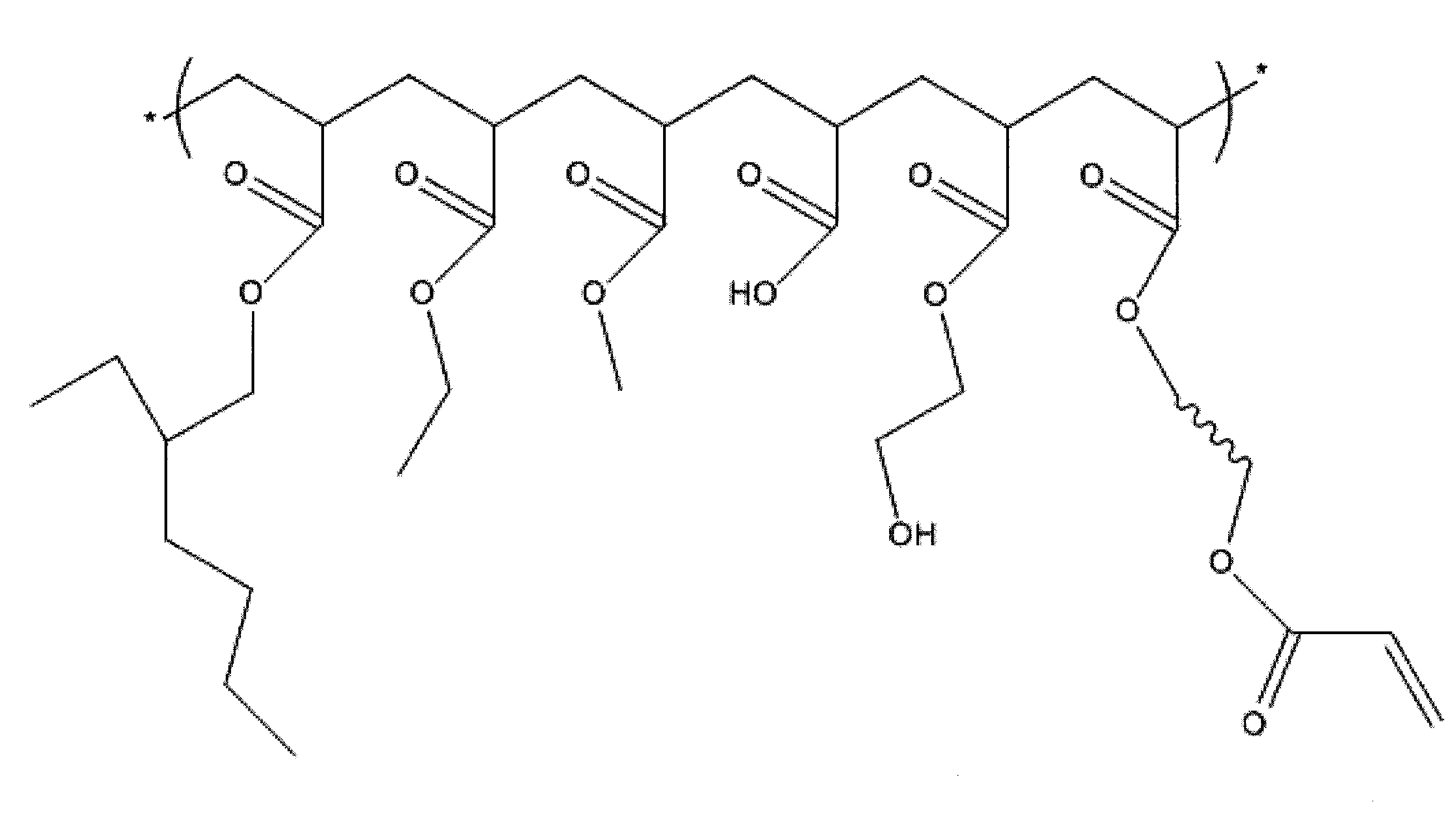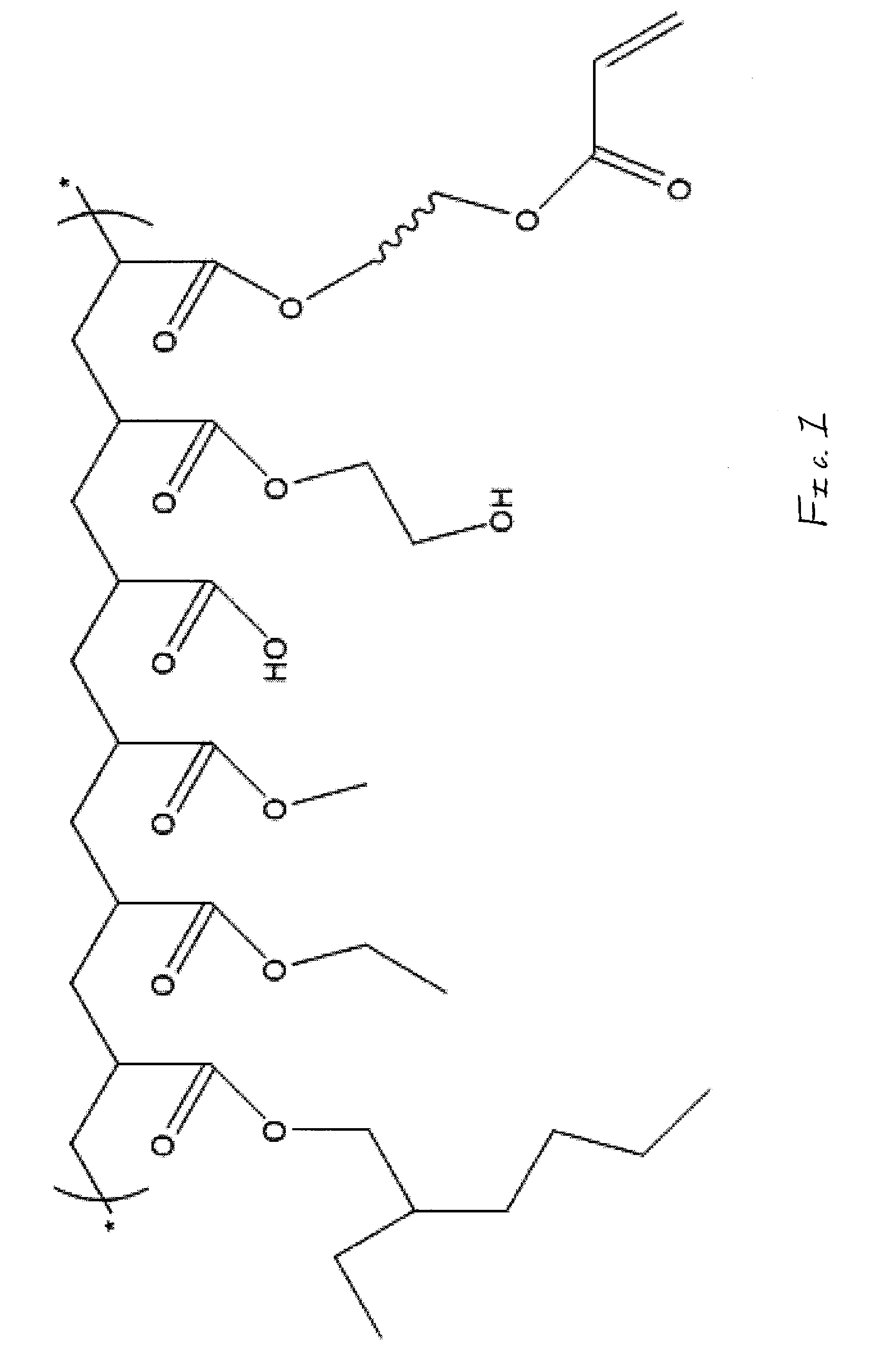Ultraviolet radiation curable pressure sensitive acrylic adhesive
a pressure sensitive acrylic and ultraviolet radiation technology, applied in the field of ultraviolet radiation curable pressure sensitive adhesives, can solve the problem that the acrylic polymer itself is not uv curable, and achieve the effects of reducing the level of free ipdi, reducing the amount of ipdi, and reducing the cost of production
- Summary
- Abstract
- Description
- Claims
- Application Information
AI Technical Summary
Benefits of technology
Problems solved by technology
Method used
Image
Examples
example 1
Base Polymer Synthesis
[0041]A mixture of monomers and chain transfer agent having the components set forth below was prepared.
607 g2-Ethylhexyl Acrylate189 gEthyl Acrylate150 gMethyl Acrylate 25 g2-Hydroxyethyl Acrylate 25 gAcrylic Acid 4 g1-Dodecanethiol
[0042]This mixture of monomers and chain transfer agent was placed in an addition tank with a feed pump. 355 g of ethyl acetate was added into a 2-liter water jacketed reactor. The jacket temperature was set to 85° C., and the ethyl acetate was heated until a good reflux was obtained. Also, a slow nitrogen purge passed through the headspace of the reactor. The reactor contents were stirred at 130-150 rpm during the course of the reaction. Separately, a solution of 4 g dilauroyl peroxide and 37 g of ethyl acetate were prepared. After 20 minutes of solvent reflux, the monomer solution and the peroxide solution were separately fed into the reactor. Monomer feed time was 90 minutes and peroxide feed time was 120 minutes. At the end of t...
example 2
[0048]The base polymer described in Example 1 was derivatized at 4.4% active derivatizing agent, which had an HEA / IPDI ratio of 1.12:1. The derivatized base was then formulated as shown below, on a solids basis:
72.4 g Derivatized Base Resin13.0 g Pinova FORAL 85 Rosin Ester Tackifier9.0 gPinova FORAL 105 Rosin Ester Tackifier2.6 gRahn AG M3130 Trifunctional Acrylate2.0 gLamberti ESACURE KIP150 Photoinitiator1.0 gCytec Industries, Inc. P-36 Photoinitiator
[0049]Adhesive films were prepared from this formulation at 1.3 mils thickness and cured at 125 ft / min on the Fusion Systems 600-Watt unit with an H-bulb. Adhesive performance was measured by 180° Peels, RT Shear adhesion failure time, 160° F. Shear adhesion failure time and 200° F. Shear adhesion failure time. The 180° Peels on SS (24-hour dwell) resulted in 4.6 lb / in with adhesive failure and 180° Peels on HDPE (24-hour dwell) resulted in 2.0 lb / in with adhesive failure. RT Shear adhesion failure time (1″×1″×1 kg) was greater than ...
PUM
| Property | Measurement | Unit |
|---|---|---|
| thickness | aaaaa | aaaaa |
| thicknesses | aaaaa | aaaaa |
| Tg | aaaaa | aaaaa |
Abstract
Description
Claims
Application Information
 Login to View More
Login to View More - R&D
- Intellectual Property
- Life Sciences
- Materials
- Tech Scout
- Unparalleled Data Quality
- Higher Quality Content
- 60% Fewer Hallucinations
Browse by: Latest US Patents, China's latest patents, Technical Efficacy Thesaurus, Application Domain, Technology Topic, Popular Technical Reports.
© 2025 PatSnap. All rights reserved.Legal|Privacy policy|Modern Slavery Act Transparency Statement|Sitemap|About US| Contact US: help@patsnap.com


